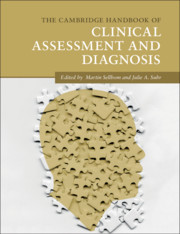Book contents
- The Cambridge Handbook of Clinical Assessment and Diagnosis
- The Cambridge Handbook of Clinical Assessment and Diagnosis
- Copyright page
- Contents
- Figures
- Tables
- Contributors
- Acknowledgments
- 1 Introduction to the Handbook of Clinical Assessment and Diagnosis
- Part I General Issues in Clinical Assessment and Diagnosis
- Part II Specific Clinical Assessment Methods
- Part III Assessment and Diagnosis of Specific Mental Disorders
- Part IV Clinical Assessment in Specific Settings
- Index
- References
1 - Introduction to the Handbook of Clinical Assessment and Diagnosis
Published online by Cambridge University Press: 06 December 2019
- The Cambridge Handbook of Clinical Assessment and Diagnosis
- The Cambridge Handbook of Clinical Assessment and Diagnosis
- Copyright page
- Contents
- Figures
- Tables
- Contributors
- Acknowledgments
- 1 Introduction to the Handbook of Clinical Assessment and Diagnosis
- Part I General Issues in Clinical Assessment and Diagnosis
- Part II Specific Clinical Assessment Methods
- Part III Assessment and Diagnosis of Specific Mental Disorders
- Part IV Clinical Assessment in Specific Settings
- Index
- References
Summary
This introductory chapter provides an overview of the structure and content of The Cambridge Handbook of Clinical Assessment and Diagnosis. Cross-cutting themes from the chapters are considered within the context of elements of a good clinical psychological assessment. More specifically, the various parts of clinical assessment, including referral, sources of information, differential diagnosis, clinical formulation, and report writing, along with considerations for noncredible reporting and cultural considerations, are discussed. For each component of a clinical assessment, reference to more detailed information in specific chapters is provided. This chapter ends with a call for future developments in clinical psychological assessment, with an emphasis on various technological advances to further bring assessment practices into the twenty-first century.
Keywords
- Type
- Chapter
- Information
- Publisher: Cambridge University PressPrint publication year: 2019



